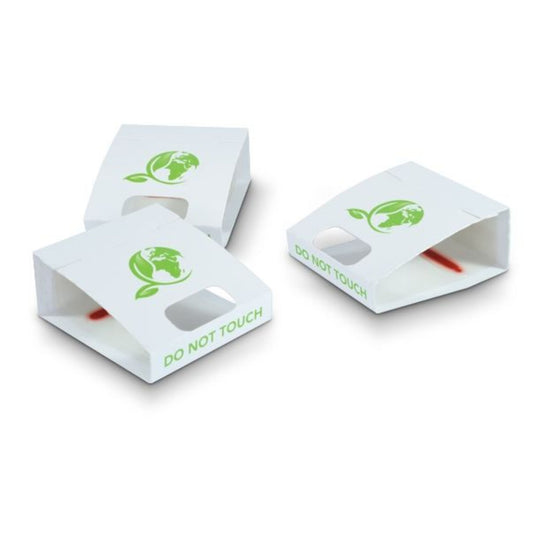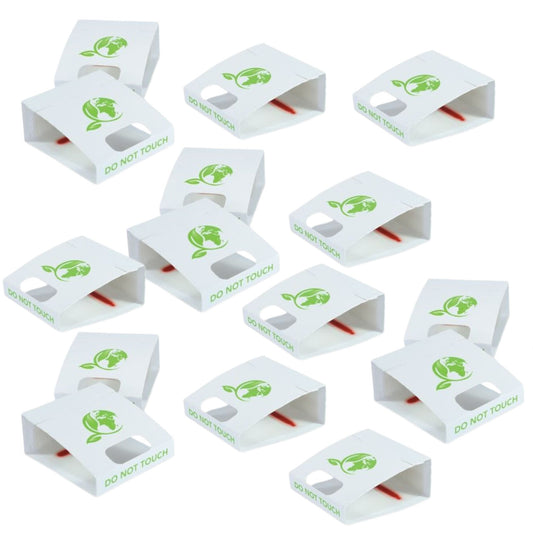
Expert Guide on How to Get Rid of Silverfish Yourself
Share
Discovering silverfish in your home can result in major concern. These undesirable pests thrive in damp conditions. Worse still, if not tackled right away, silverfish can cause substantial damage. This is especially true for paper, wallpaper and other starchy materials.
Although pest control professionals can help remove silverfish, you can also solve the problem by yourself at a more affordable cost. This requires you to have proper, effective supplies and follow PestBuddy's recommendations.
This guide provides a straightforward approach for identifying, preventing, and removing silverfish yourself. By following these steps, you can protect your home or workplace and maintain a silverfish-free environment.
What Are Silverfish?
Silverfish are small, silver-grey, wingless insects with long-round bodies up to 10-15mm long. They are often described as being "cigar-shaped". Silverfish are known for their quick, fish-like movements which is how they got their name. They are most commonly found in damp, hot or humid areas such as kitchens, boiler rooms and bathrooms.
Although silverfish are nocturnal, they can be spotted throughout the day. They are very prone to being discovered in baths, sinks or chinaware. This is because they struggle to climb smooth surfaces. A distinctive feature of silverfish is the three long bristles at their tail end. They are also notorious for feeding on starchy substances including glue, wallpaper paste, and other carbohydrate-rich food sources.

Silverfish Behaviour
Understanding silverfish behaviour is crucial for identifying and controlling them effectively. Their lifecycle, feeding habits, and environmental preferences all play a role in explaining their behaviour.
Silverfish Lifecycle
Silverfish have three main life stages starting as an egg, hatching into a nymph, and maturing as an adult.
Eggs: Silverfish lay eggs in small gaps, cracks and crevices. This most commonly happens in damp, hot, humid areas. Silverfish eggs are tiny and white which makes them difficult to spot. Depending on environmental conditions, the eggs can take anywhere from a few weeks to 2 months to hatch.
Nymphs: Once hatched, silverfish nymphs resemble smaller versions of adult silverfish. They undergo a series of moults where they shed their skins, gradually growing larger each time. During this stage, they fondly seek out starchy materials for food.
Adults: Adult silverfish are about 10-15mm long, with a distinctive silver-grey colour. They reach adult maturity after 3-4 months in ideal conditions, typically living for anywhere between one to three years. In cooler climates, it can take up to 2 years to reach maturity.
Adult silverfish continue to moult throughout their lives with some species reporting to moult up to 50 times. One notable species of silverfish can regenerate lost legs during subsequent moults.
Silverfish Reproduction
Female silverfish can produce eggs throughout the year. They produce up to 3 eggs per day or clusters up to 20 eggs in size. The eggs are deposited in hard-to-find places including cracks around the inside of the bathroom, kitchen or attic. Their ability to lay so many eggs so quickly is the reason why taking action against silverfish is important.
What Do Silverfish Eat?
Silverfish are known for their preference for eating starchy materials. Their diet includes:
- Starch and Carbohydrate: Silverfish love feeding on starchy substances such as glue, wallpaper paste, and even book bindings. They are also known to be attracted to carbohydrate food debris, including potatoes, cereals and crumbs.
- Protein: Although less common, silverfish may also consume silk, dead insects, and even other silverfish if food is scarce.

Understanding the feeding habits of silverfish may help you identify potential infestation sites. This will allow you to quickly take effective prevention measures to limit their ability to thrive and multiply.
Silverfish and Damp Conditions
Silverfish thrive in damp, warm and humid environments. This often indicates underlying dampness and moisture problems in the home. To prevent infestations before they occur, it's essential to address the damp conditions in which they thrive.
- Kitchens and Bathrooms: These areas are particularly prone to silverfish due to high humidity levels. Ensure proper regular ventilation and use exhaust fans to reduce moisture.
- Basements and Attics: These areas often have higher humidity levels and are less frequently cleaned. This makes them ideal habitats for silverfish. We recommend using dehumidifiers to keep these spaces dry.
By understanding the silverfish lifecycle, you can prevent and control infestations. Regular cleaning, humidity control, and removal of starch-rich food sources are key steps to keep your home silverfish-free.
Identifying Silverfish Infestations
Recognising a silverfish infestation early is crucial for effective management as they can breed very quickly if not. Here are the key signs to look out for:
Physical Sightings
Silverfish are most commonly spotted in moist, humid environments. This includes bathrooms, kitchens, basements, and attics. Their quick movements and distinctive appearance make the adults relatively easy to identify.
Damage to Starchy Materials
Silverfish like to feed on starchy materials, so look for signs of damage on paper, books, wallpaper, cardboard, and fabrics. They leave irregular holes and may also produce yellow stains on infested items.
Shed Skins and Droppings
As they grow, silverfish shed their skins, which can accumulate in infested areas. Their droppings are small, pepper-like pellets that may be found near their feeding sites.
Preventing Silverfish
Preventative measures are essential for managing silverfish and reducing the risk of infestation. Here are several effective strategies:
Reduce Humidity
Silverfish thrive in humid conditions. Use dehumidifiers in damp areas and ensure good ventilation throughout your home. Fix any leaks and use exhaust fans in bathrooms and kitchens to keep these areas dry.

Regular Cleaning
Maintain a consistent cleaning routine involving regular vacuuming and dusting. This is especially true in less disturbed areas like behind furniture and in closets. Pay special attention to areas where crumbs and food debris may accumulate.

Proper Storage of Materials
Store paper products, books, and fabrics in airtight containers. Use plastic bins with tight-fitting lids to protect these items from silverfish.
Seal Entry Points
Inspect your home for potential entry points, such as cracks and crevices around windows, doors, and pipes. Seal these areas to prevent silverfish from entering your home.

Natural DIY Silverfish Control
Natural methods are preferable for managing silverfish infestations before resorting to chemical solutions as they are generally safer for both your health and the environment compared to chemical treatments. Here are several non-chemical methods to help control silverfish:
Essential Oils: Cedar oil, lavender, and citrus oils are natural repellents for silverfish. Spray these oils in affected areas to deter silverfish from inhabiting those spaces.
Diatomaceous Earth: A fine, natural powder that dehydrates and kills silverfish upon contact. Apply it to areas where silverfish are frequently found, such as along skirting boards, behind furniture, and in damp corners.
Non-Toxic Silverfish Traps: Pre-baited or sticky silverfish traps can help capture silverfish and monitor activity in your home. Place these traps in dark, humid areas such as bathrooms, basements, and under sinks.
Homemade Traps: A simple but effective DIY option is to use small glass jars with sticky tape on the outside. Silverfish climb the tape to get into the jar but are unable to escape due to the smooth, sticky interior.
Chemical Solutions for Silverfish
If natural solutions are not effective, chemical interventions may be necessary. Before using any chemical products, study the ingredients and potential side effects. Always read and follow the instructions carefully.
Non-Toxic Insecticide Sprays: A natural insecticide can be sprayed in affected areas, such as cracks, crevices, and behind furniture, to kill silverfish while minimizing chemical exposure.
Residual Insecticide Powders or Sprays: Specifically designed for silverfish control, these treatments should be applied in areas where silverfish are active, including skirting boards, baseboards, and storage spaces.

Cleaning and Repairing After Silverfish Infestations
After addressing the initial infestation, thoroughly clean and repair affected areas.
Deep Clean
Vacuum and steam clean infested areas to remove any lingering eggs, nymphs, or food sources. Pay special attention to cracks and crevices where silverfish may hide.
Repair Damaged Areas
Fix any water leaks and repair damp areas to prevent future infestations. Replace or repair damaged wallpaper, books, and other materials affected by silverfish.
When to Use Professional Pest Control Services for Silverfish
If a silverfish infestation persists despite your best efforts, it may be time to call in professionals. Pest control services can offer more powerful and targeted solutions. They may also offer customised advice to ensure your infestation is handled quickly and effectively.
Final Thoughts
We've shared our recommendations on how to stop silverfish yourself. By implementing the strategies in this guide, you can effectively manage silverfish infestations at home or work.
Remember that early identification and prompt action are key to success. Regular cleaning, humidity control and storage of food sources can reduce the chances of infestation.
If DIY methods do not work for you, don't hesitate to seek professional help. Taking control of your environment will help maintain a healthy, pest-free home.
At PestBuddy, we're here to empower you with effective, fast and easy-to-use DIY silverfish control products. Explore our range of products to take control of your pest problems with confidence.






